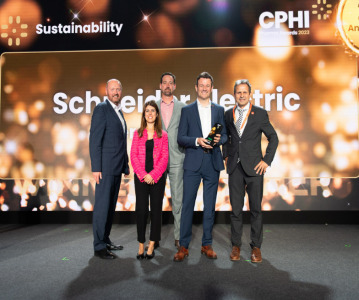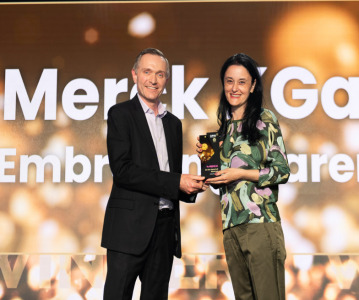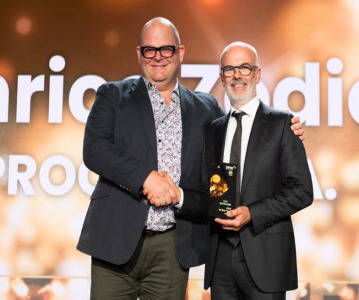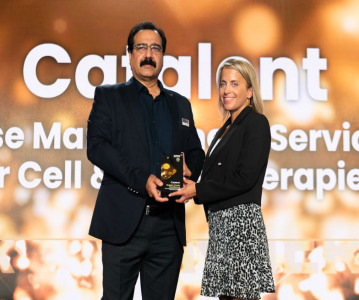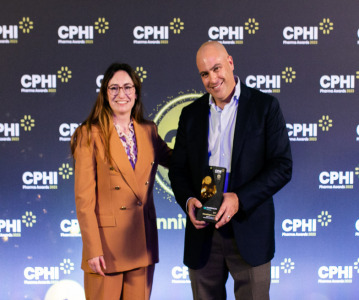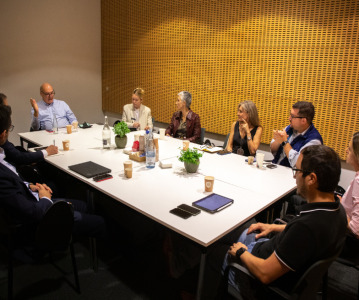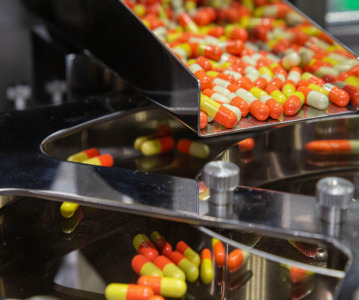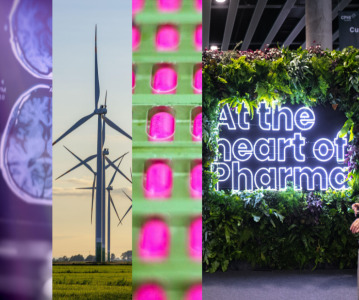CPHI Pharma Awards 2023 – Packaging & Machinery Winner: Gasporox
.png)
After another year of impressive nominations for the CPHI Pharma Awards our winners were announced at CPHI Barcelona in October 2023. In this series of interviews, we speak to the people and teams behind the award-winning projects, concepts, and technologies.
In this interview, CEO of Gasporox Märta Lewander Xu tells us about the evolution of the company and their winning product, the AutoMAP solution. She emphasises how even a smaller company can have a big impact on the industry if they have something special to offer.
Please could you give a bit of background to Gasporox and the aims and goals of the company?
Gasporox is fundamentally a tech company. We are a small company with the origin from the university here in Lund, so I would say in some sense we are a start-up company.
In the next phase as a very entrepreneur-driven company, I was part of the research group that founded this company and I have a PhD in laser spectroscopy for package inspection.
Gasporox is about having unique technology. We are a small actor with a highly specialised technology, and we are really, really good at what we do and we are introducing this kind of novel technology for different parts of the packaging industry. I would say pharmaceutical vials and lyophilised vials in particular, is one of our main applications.
What is really unique with our solution is that it's non-destructive, it’s fast and it’s robust, meaning you can implement it directly in line. So for vials, we inspect up to 600 vials per minute, which is more than the typical production speed.
So this is really what Gasporox is about. The technology supplier for the inspection of pharmaceutical containers, but also food containers, we have some products, with some applications in food, but the application is a little bit different, but it's all about package inspection and gas detection with laser.
You won the award for the Gasporox AutoMAP pharma. Can you tell us more about this particular product in a bit more detail please?
We have a background in pharmaceutical vial inspection, but we get a lot of requests in both food and pharma, what you can measure inside food packages, or say, pharmaceutical packages with flexible film. So for us the package type is flexible film and then we were thinking of what can be our technical solution here, and we are using more or less a similar approach as we are doing with vials.
However, we need to have a guide for the samples here with some suction cups to shape the flexible film into a dome. This is what we made into this AutoMAP product and this is applicable both to pharmaceutical packages and food packages.
I would say that at first they have gone in parallel, but the name (AutoMAP) comes from a food-inspired application where MAP is Modified Atmosphere Packaging. So, automatic measurement of MAP.
For the pharma side, I would say it's a totally new equipment where you can do non-destructive testing of these samples.
It started with a bench top unit where you could do a single sample testing and then we push to really get it to in line because that's really where we really need it.
That's typically where we are operate and the AutoMAP product is that the in line sensor for this, the same technology for what we call packages with flexible film such as injectables in flexible films, typically IV bags or some nutritional packaging or something similar in food, it can be everything from processed meat like ham or cheese to ready meals or fresh pasta. With this product, we can reach quite wide in the segment.
What challenges have you encountered in developing the Gasporox AutoMAP solution in food and in pharma and how have you worked to overcome these?
I would say there's two parts to this.
Firstly, when you develop a product you always have the technical challenges that you need to solve, but we have a good engineering team and a development team that works to overcome these. Then there's the other challenging part that is how do you get a product that solves a need in the market, and here you need good communication with the customers.
We have developed this product in different pilot projects together with the industry, industrial actors, both in food and pharma to really get a product that addresses their needs.
We had early collaboration with pharmaceutical actors and with food actors and that is the way we have resolved these issues.
One challenge with the product itself is that, as I said, it can be used so widely, but then you cannot do everything at the same time, you need to know what to focus on. So we have developed a model whereby we work case by case in pilots and then expand from there.
Do you find that that's quite time-consuming going case by case?
I would say that you're paying in some sense with a longer time in development, but at the same time, you get a product that is very well suited so you save time here because you work very early with the market. This mitigates the risk of developing something very quickly, but that isn’t what the market wants. This way, you have a more optimal product, earlier, and as a flexible actor we can react and interact with the partners in a very efficient way, making this a suitable model for us.
This is quite new technology still, but how do you hope that it will be used to help with things like regulatory compliance, again in food and pharma?
I think inspection in general has been highlighted more and more.
We had the new Annex 1 coming now in the production of sterile pharmaceuticals and generally speaking, I would say that inspection is more and more critical and needed in the industry.
I would also see a general trend to move towards more inline and automated testing and larger batch testing.
It’s worth noting that with this you also need something to be non-destructive and automated that you can automate into your production line. This is where our solution comes in.
Addressing how this fits today into the regulatory landscape is a little bit more tricky to answer because it's still new so there is no defined regulatory pathway of this is how it should be.
Having said that, I would divide it into two parts, one is connected to more oxygen sensitive products where you need to make sure, and be able to demonstrate that there is no oxygen inside your package. Here we can really show that and give the right type of report that you’d need.
The other point is more to do with container closure integrity testing and here you need to verify that the package is not leaking gas, in or out, and there is more of a method connected to it and this is something we now need to develop further.
There's more to work to be done here, but I think this product will be an important tool to show this both for oxygen sensitive products, but also in the future, maybe for Container Closure Integrity testing.
This solution represents a really big step in packaging solutions. How will this help to revolutionise packaging systems and help them to become more sustainable?
If I start in more short term and then go more visionary, I would say short term, today a lot of destructive testing is done and with that you create a lot of waste, waste of food package or the packaging material, but also the content.
So it's where we have an overproduction that is wasted, but rather what we want is that more or less everything that is produced should go to the end user and the clinic that has bought them.
I think that is one important part of sustainable production, having non-destructive good inspection and quality. By having good inspection, we can ensure that the things we produce can be used.
There could be cases where you find an issue too late to really have that however, everything that could go out from a factory could be quality inspected before leaving, instead of having a batch that you have done for one hour and then you have to destroy because you found an issue.
Moving over to an automated inspection is how I see the future. I would also like to see identifying things before it becomes an issue. For example, we can often identify trends before it goes higher than a certain threshold, and to be able to act before that is always valuable. I really see that this can is an important tool for having an efficient and safe production system.
What does winning the award mean to you as a business and how will it help you as a company?
For us it means a lot, especially for my team, to show that what we developed makes a difference for the industry.
We are a very small company and we do very niche products and very technical things.
So to really understand that it's this place, a key into a larger value chain where we make a bigger impact in the full chain, it represents an appreciation of that.
It reinforces how we have decided to be a full focus company on a specific problem and to be able to show that we can really offer support with our new technology to solve your problem here and that it can be that you don't have to be the largest company or have the most products but you just need to be really good at what you do and this is where we are really good at what we do and here is how we can make a difference for the industry. This is what the spirit of the company is about too, that we have a technology that we really want to help the industry and this award shows that we can deliver on that.
It also means good publicity so more people hear about our solution and our company, which is very important for us too.
So what does the future hold for Gasporox? Then what more projects do you have in the pipeline and any more innovative ideas on the horizon?
Gasporox is a company on a journey. I think this is just the beginning of us and we are coming with a new technology into an industry.
There's many things left to be done here in different package materials and packet container types and going from the pharmaceutical perspective to food. We need to be able to adapt our products for different applications and understand what our customers need. So far our model works with pilot customers and market actors, and I’m confident that it will show new innovative products all the time.
We also have a super interesting project about inspections of tablets, which is not a finished product as yet, but we are developing a new technology for tablet inspection and that would be great to complement our package inspection.
Do you have any final comments?
Only that I didn't think we could win to be honest. I was so happy that we did and I'm happy that we as a small actor with a very specialised high tech product that maybe not everyone understands why they might need it, but it is needed and it makes a difference and I'm glad that has been recognised.
See more about the AutoMAP solution by clicking the button below.
Related News
-
News CPHI Pharma Awards 2023 – Sustainability winners: Schneider Electric
After another year of impressive nominations for the CPHI Pharma Awards our winners were announced at CPHI Barcelona in October 2023. In this series of interviews, we speak to the people and teams behind the award-winning projects, concepts, and techno... -
News CPHI Pharma Awards 2023 – At the Heart of Pharma winners: Merck KGaA
After another year of impressive nominations for the CPHI Pharma Awards our winners were announced at CPHI Barcelona in October 2023. In this series of interviews, we speak to the people and teams behind the award-winning projects, concepts, and techno... -
News CPHI Pharma Awards 2023 – CEO of the Year Winner: Enrico Zodio, PROCOS S.P.A.
After another year of impressive nominations for the CPHI Pharma Awards our winners were announced at CPHI Barcelona in October 2023. In this series of interviews, we speak to the people and teams behind the award-winning projects, concepts, technologi... -
News CPHI Pharma Awards 2023 – Supply Chain Excellence Winners: Catalent Case Management Services
After another year of impressive nominations for the CPHI Pharma Awards our winners were announced at CPHI Barcelona in October. In this series of interviews, we speak to the people and teams behind the award-winning projects, concepts, and technologie... -
News CPHI Pharma Awards 2023 – API Development and Innovation Winners: Snapdragon Chemistry, a Cambrex Company
After another year of impressive nominations for the CPHI Pharma Awards our winners were announced at CPHI Barcelona in October. In this series of interviews, we speak to the teams behind the award-winning projects, concepts, and technologies. -
News Navigating the Future: Challenges and Opportunities in Pharma Innovation and Investment – CPHI Barcelona 2023 Roundtable Report
In this comprehensive downloadable report, hear from a range of experts in finance and investment in the pharma industry on what investment trends will be shaping the future of the industry, in Catalonia, and the wider world. -
News CPHI Barcelona: Outsourcing in Manufacturing Operations
During CPHI Barcelona 2023, insightful content sessions offered attendees the chance to explore trending topics with expert speakers and panellists. Here, we summarise what the pharma industry and supply chain are talking about the most. -
News CPHI Podcast Series: The 2023 Retro – what have we learnt from the past year in pharma?
Welcome to the last episode of 2023! Digital Editor Lucy Chard is joined by her teammates in a special retrospective episode to close out the year. Guests Vivian Xie, Editor for CPHI Online and Tara Dougal, Content Director for Pharma, discuss their hi...
Position your company at the heart of the global Pharma industry with a CPHI Online membership
-
Your products and solutions visible to thousands of visitors within the largest Pharma marketplace
-
Generate high-quality, engaged leads for your business, all year round
-
Promote your business as the industry’s thought-leader by hosting your reports, brochures and videos within your profile
-
Your company’s profile boosted at all participating CPHI events
-
An easy-to-use platform with a detailed dashboard showing your leads and performance

